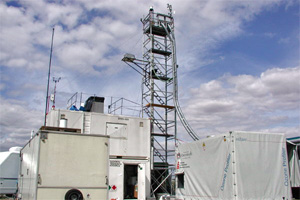Centre for Atmospheric Science contribution to the Atmospheric Measurement Facility (AMF)
What is AMF?

The Atmospheric Measurement Facility provides quality-controlled data products from state-of-the-art mobile instrumentation, atmospheric observatories and laboratories.
Observational measurements are at the heart of environmental science, allowing researchers to develop and test hypotheses. AMF enables scientists to make atmospheric measurements and observations around the world, through the provision of instrumentation, deployment logistics, and scientific and technical expertise.
AMF is at the forefront of the rapidly changing research and technology landscape, leading the standardisation of archivable data products, and is working with end-users to make it easier for the science community to access data.
Find access to long-term data sets and instrument specifications on the AMF webpages.
Facilities hosted by the Centre for Atmospheric Science
The University of Manchester Centre for Atmospheric Science hosts in situ and remote sensing instrumentation for the study of clouds, aerosols, radiation and dynamics. This includes several instruments for use on the FAAM research aircraft. We also host infrastructure to support these instruments such as mobile laboratory facilities etc. There are four AMF instrument scientists at The University of Manchester they are Dr. James Dorsey (cloud microphysics instrumentation), Dr. Paul Williams (aerosol instrumentation), Dr. Emily Norton (remote sensing instrumentation) and Dr. Hugo Ricketts (remote sensing instrumentation). The instrument scientists are responsible for the operation and maintenance of the AMF instruments, and provide support for them during field deployments, as well as analyzing data and contributing to publications. They are also involved with continual development and improvement of the instruments and facilities available, and developing improved methods of data analysis.
On our website, you can find a list of instruments and facilities hosted at the centre, and a list of publications resulting from projects using AMF equipment. Almost all our AMF facilities have been used extensively, often on several major projects each year, with some in use almost continuously. A few major projects which have made extensive use of AMF equipment are described in more detail on our project pages. These include ACTIVE, CLACE4, CSIP, RHaMBLe, TROSIAD and DIAMET.